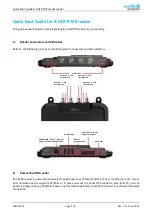
TST-019 MRTALPCH CHANNEL
– Rev. 2016-310
Page 15 of 20
PAD SYSTEM TESTS
Note: This section assumes it was determined that either the vacuum generating system does not
leak or that any existing leaks in the vacuum generating system have been repaired up to the filter
connections.
Note: The following assumes that you have access to suitable plugs, a ball valve with vacuum
gauge, and additional hose and adapter fittings for connecting the ball valve to the lifter’s vacuum
lines and fittings.
Note: If you are testing only one of the two circuits, the lifter will need to be attached to a clean,
smooth surface for the remaining section to seal during testing.
Isolate the vacuum pads, fittings and vacuum line sections until the leak point can be located, as
follows:
1) If not already attached, reattach
the filter lines to reconnect the
vacuum generating system to the
pad system.
2) Remove each pad fitting from the
vacuum pads of the affected
(leaking) circuit, disconnecting
the pads of this circuit from the
vacuum system.
3) Cap the pad fittings of the
disconnected pads, to seal off
the vacuum lines. See
FIGURE 21
,
where all 6 pad fittings are shown capped off; red circuit shown in top views and green circuit
shown in bottom views.
Note: If only one set of pads (green or red circuit) is capped off, the lifter will need to be
attached to a clean, smooth surface for the remaining section to seal during testing.
4) With the vacuum pads capped off (all or just one set of pads), switch the power on
( )
, and
activate the vacuum generating system by pressing the apply
( )
push button.
5) Allow the vacuum system to reach a suitable vacuum level or to shut off automatically, then
switch the power to off
( )
and observe the lifter’s vacuum gauge(s) to determine the area of
the leak.
If the vacuum level shown on
the lifter’s vacuum gauge for the circuit (red or green) that is
being tested holds steady and does not drop, this indicates the leak is in one or more pads
of that circuit. Reconnect one pad to its vacuum line and retest. If indications of leakage
resume, replace that pad. Continue testing until all pads have been reconnected and all
defective pads have been identified and replaced.
If the vacuum level shown on
the lifter’s vacuum gauge for the circuit (red or green) that is
being tested starts and continues to drop, this indicates the leak is located in the fittings,
quick connects, or vacuum lines between the vacuum pads and the filter.
If it is determined that the leak is between the pads and the filters, continue testing as
follows. Note, the pad fittings should still remain capped off for the following tests.
FIGURE 21
Содержание MRTALPCH611LDC
Страница 2: ...TST 019 MRTALPCH CHANNEL Rev 2016 310...







































